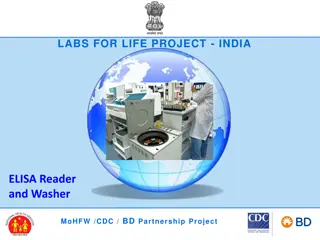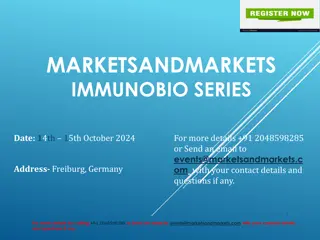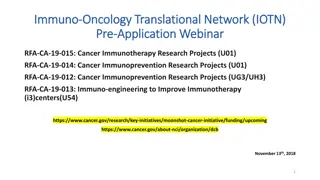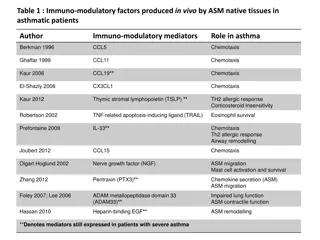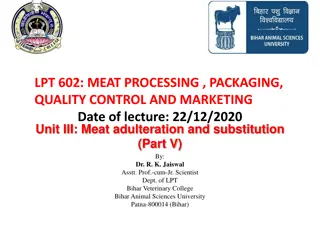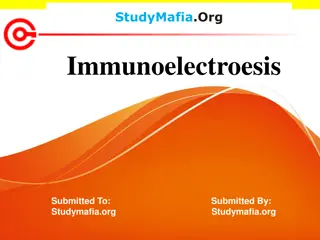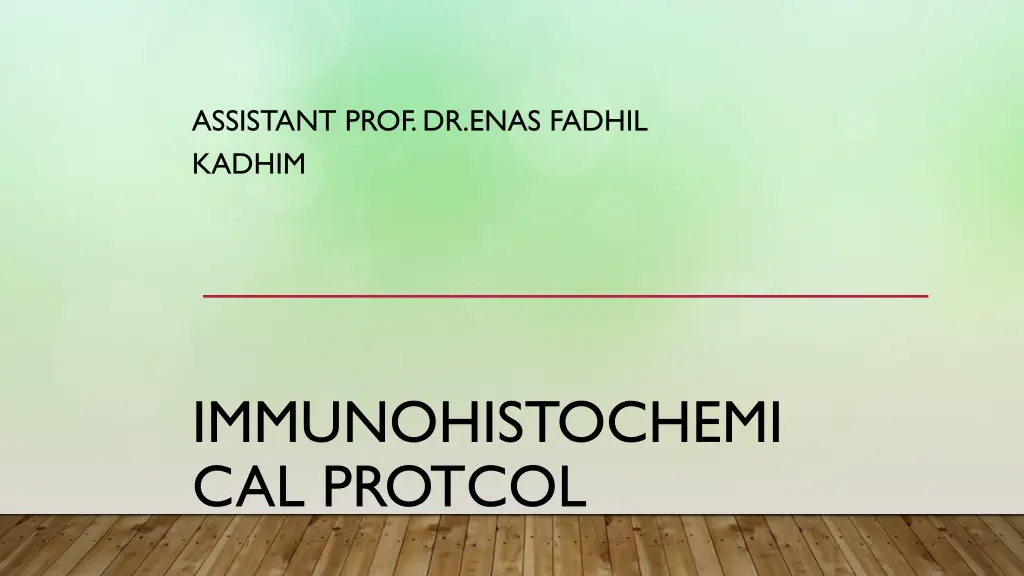
Immunohistochemistry Protocol and Fixation Methods
Learn about immunohistochemistry (IHC) protocols using antibodies to detect proteins in tissues, fixation methods like formaldehyde and alcohols, and the importance of sample preparation for accurate protein expression evaluation.
Uploaded on | 0 Views
Download Presentation

Please find below an Image/Link to download the presentation.
The content on the website is provided AS IS for your information and personal use only. It may not be sold, licensed, or shared on other websites without obtaining consent from the author. If you encounter any issues during the download, it is possible that the publisher has removed the file from their server.
You are allowed to download the files provided on this website for personal or commercial use, subject to the condition that they are used lawfully. All files are the property of their respective owners.
The content on the website is provided AS IS for your information and personal use only. It may not be sold, licensed, or shared on other websites without obtaining consent from the author.
E N D
Presentation Transcript
ASSISTANT PROF. DR.ENAS FADHIL KADHIM IMMUNOHISTOCHEMI CAL PROTCOL
Immunohistochemistry (IHC) uses antibodies to detect cell and tissue proteins and provide semi-quantitative data about target protein expression, distribution, and localization. Tissues are sectioned from fixed embedded (e.g. IHC-Paraffin or plastic) or frozen blocks (e. g. IHC-Frozen), and the sections are then probed with primary antibodies against the antigens of interest..
Target expression can be evaluated with the corresponding labeled primary antibody (direct detection) or, more commonly, with the addition of labeled secondary antibodies (indirect detection). The label, either fluorescent or enzymatic, is used to visualize the antigen-antibody complex
SAMPLE PREPARATION AND FIXATION Standard Fixatives Aldehydes 4% formaldehyde in phosphate-buffered saline (PBS) is the most common fixative for preserving protein targets in tissues.
Formaldehyde reacts with amino groups in proteins to form methylene bridges that crosslink proteins in tissue sections. These molecular cross- links can mask protein epitopes from antibody binding and may require the addition of an antigen retrieval step for proper IHC staining.
Additionally, formaldehyde-mediated tissue fixation has been shown to induce translocation of phosphorylation-dependent epitopes from the membrane to the cytoplasm
Alcohols The predominant alcohols used for fixation are 70% methanol and 80% ethanol. Alcohols work by removing and replacing water molecules in tissue, which can destabilize hydrophobic bonds and alter the tertiary structure of proteins. This also causes the precipitation of soluble proteins, making alcohol-mediated fixation more appropriate for detection of membrane bound proteins.
Acetone Acetone is also used as a strong dehydrant and precipitant, typically applied to sections of snap-frozen tissues. Acetone fixation is generally mild and may be followed by fixation with alcohols or formaldehyde.
PROTOCOL: 4% FORMALDEHYDE SOLUTION IN PBS 1-For 1 L of 4% formaldehyde, add 100 mL of 10X PBS and 700ml distilled water to a glass beaker on a stir plate in a ventilated hood. Heat while stirring to approximately 60 C. Make sure that temperature of the solution does not exceed 60 C.
2- Add 40 g of paraformaldehyde powder to the heated PBS solution. Note: The powder will not immediately dissolve into solution. Slowly raise the pH by adding 1 N NaOH dropwise from a pipette until the solution clears.
3- Once the paraformaldehyde is dissolved, the solution should be cooled and filtered. 4- Adjust the volume of the solution to 1 L with distilled water. 5- Recheck the pH, and adjust it with small amounts of dilute HCl to approximately 6.9. Note: The solution can be stored at 2-8 C for up to one month.
PROTOCOL: FORMALIN-FIXED, PARAFFIN-EMBEDDED (FFPE) 1- Fix the tissue of interest by immersing it in 10% neutral buffered formalin (4% formaldehyde) for 4-24 hours at room temperature. Fixation time and temperature depends on tissue type/size. After fixation, wash the tissues 3x in PBS.
2- Dehydrate by full immersion of tissue in the following solutions (2x for 30 minutes each): a) 70% Ethanol b) 95% Ethanol c) 100% Ethanol d) Xylene
3- Embed the tissue in molten paraffin. After the paraffin solidifies keep the blocks at 4C until sectioning. Note: Paraffin melts at 57 C. 4- Keep FFPE blocks chosen for sectioning tissue face down in an ice water bath, to hydrate the tissue and avoid cracking during sectioning. Certain tissues (e.g. liver or spleen) require this to be repeated after 10-20 cut sections.
5- Use a microtome to cut the paraffin tissue blocks into 4-10 m thick sections and transfer them to a 37 C water bath with distilled water.
6- Pick up the floating tissue section using a clean histological slide (coated with gelatin or poly-L-lysine to improve adhesion of tissue sections) and allow mounted tissue sections to dry for about 30 min on a 37 C hot plate followed by baking them for 2-3 hours in a 40 C oven. Slides can be safely stored at room temperature until ready for staining. Storage of cut slides for longer than 1 month is usually not recommended.
EPITOPE (ANTIGEN) RETRIEVAL Formalin is a superior fixative for preserving morphology, but it also adversely impacts IHC staining by masking antigens and restricting antibody-target binding. Masking is the result of crosslinks created between amino acids within the target antigen and between proteins surrounding the target antigen. Crosslinks can impede an antibody from accessing its epitope, limiting the ability to detect antigens in formalin-fixed tissue samples. This results in a weak signal or a signal that is indistinguishable from the background. Masked epitopes can be recovered with an antigen retrieval step, which works to promote epitope availability and enhance immunogenicity Proteolytic-Induced Epitope Retrieval (PIER) and Heat-Induced Epitope Retrieval (HIER) are two of the most widely used antigen retrieval methods for FFPE tissue sections.
First select one of 3 HIER buffer options: Citrate Buffer - 10mM Citric Acid, 0.05% Tween 20, pH 6.0 (also see: Pre-mixed Citrate Buffer from Novus# NB900-62075) Tris Buffered Saline (TBS) - 50mM TBS, 0.05% Tween 20, pH 9.0 EDTA Buffer - 1mM EDTA, 0.05% Tween 20, pH 8.0 01 Pre-heat retrieval solution in a staining dish in a vegetable steamer until temperature reaches 95-100 C. A microwave or pressure cooker can be used as alternative heating source in place of the steamer. 02 Immerse slides in the staining dish. 03 Place the lid loosely on the staining dish and incubate it for 20-40 minutes in the steamer. 04 Remove the staining dish from the steamer and place it on the lab bench at room temperature. 05 Allow the slides to cool for 20-30 minutes before proceeding with the staining procedure.
First select one of 2 PIER buffer options: Trypsin Working Solution, 0.05% Proteinase K Working Solution, 20 g/ml 01 Cover sections with chosen PIER buffer. 02 Incubate for 10-20 minutes at 37 C in humidified chamber. 03 Allow sections to cool at room temperature for 10 minutes.
IS ANTIGEN RETRIEVAL NECESSARY? While the majority of antigens from formalin fixed tissue require an antigen retrieval step, some targets are negatively impacted by it. In some cases, this procedure can be skipped, for instance, when using an IHC-Fr tissue section, a polyclonal primary antibody, and/or optimal buffer conditions: The process of antigen retrieval on frozen tissue may be too harsh and can damage the tissue. A polyclonal antibody may enhance antigen detection compared to a monoclonal due to its ability to bind multiple epitopes. A change in pH or cation concentration of an antibody diluent; or a simple change in the incubation conditions of the primary antibody can also improve antibody affinity for an antigen.
BLOCKING NON-SPECIFIC BINDING Endogenous Activity Peroxidase Tissues with High Activity - Kidney, liver, or vascular areas with red blood cells, lysosomal membranes especially in active phagocytic cells Affected Step Chromogenic detection with HRP Block Treat tissue with 3-10% hydrogen peroxide in methanol prior to incubation with HRP conjugated secondary antibody. Background Control Before the antibody incubation step, incubate the sample with DAB substrate. The presence of endogenous peroxidase will be associated with the deposition of brown color.
Phosphatase Tissues with High Activity - Intestine, kidney, lymphoid Affected Step Chromogenic detection with AP Block Treat tissue section with 1mM Levamisole prior to incubation with AP conjugated secondary antibody. For intestinal sections, block with 1% acetic acid. Background Control Before the antibody incubation step, incubate the sample with nitro blue tetrazolium/5-bromo-4-chloro-3-indolyl phosphate (NBT/BCIP) substrate. The presence of endogenous phosphatases will be associated with the deposition of blue color.
ANTIBODIES AND DETECTION METHODS One of the most important decisions for IHC is selecting a high quality primary antibody that specifically binds the target antigen. A target protein s function, tissue and subcellular localization, along with any post-translational modifications should be taken into consideration when choosing the appropriate antibody. For example, if the protein of interest, e.g. Bax, undergoes a conformational change when activated, an antibody that specifically recognizes this activated form should be used, e.g. clone 6A7. In addition to antibody specificity, the clonality of the antibody should also be considered: monoclonal vs. polyclonal
POLYCLONAL Antibody Production Antibodies generated from multiple B cell clones. Epitopes Recognized Multiple epitopes from the same antigen


